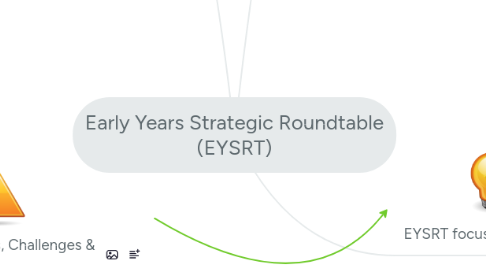
1. Participants' Objectives, Challenges & Opportunities
1.1. Improving Networking
1.1.1. Working towards network-based solutions
1.1.1.1. Difficult to get networks to work together
1.1.1.2. Difficult to network practitioners with significant diversity between them
1.1.1.3. Difficult to reach the networking hard-to-reach, easy to reach the usual suspects
1.1.1.4. Some networks are looking towards becoming cooperatives of network members / social enterprises
1.1.1.5. Facebook, LinkedIn, Google+ etc. offer significant new potential for EY networking
1.1.2. Spreading effective practice
1.1.2.1. Difficult for the effective practice to reach the spreaders
1.1.3. Achieving comprehensive geographic / cultural coverage
1.1.3.1. Barriers around sparcity, rurality, cultures
1.2. Increasing Quality
1.2.1. Supporting the recruitment, employment and promotion of EY creative/music practitioners
1.2.1.1. There's a lack of status of music/creative practitioners
1.2.1.2. There's a lack of recognised/respected standards
1.2.1.3. Difficult for settings to reliably recruit high quality music/creative practitioners
1.2.1.4. There's a lack of HE training for EY music/creative practice
1.2.2. Supporting effective commissioning by settings and services
1.2.2.1. Commissioners are driven by outputs, rather than outcomes
1.2.3. Working towards qualifications for the music education workforce
1.2.3.1. Early Years is isolated in cultural policy (e.g. Henley Reviews) from 6-19
1.3. Improving practice
1.3.1. Trying to embed creative musical practice in settings
1.3.1.1. Settings/parents have limited perceptions of what musicality / creativity are
1.3.1.2. Limited languages, which are not spoken by all
1.3.2. Trying to create musically/creatively enriched environments
1.3.2.1. Libraries, now within Bridge Orgs, can be effective locations for musical/creative practice development: sharing stories in music, dance, word etc.
1.3.2.2. Settings are focussed on targets and inspections
1.3.2.3. EYPs / parents / staff had uncreative environments when they were children
1.3.2.4. Parent lack of confidence
1.3.2.5. Practitioner lack of confidence
1.3.2.6. Start tackling lack of confidence with the 'yes you can!' approach
1.3.2.7. Cultural extension - not implantation
1.3.3. Trying to marry research findings with practice on the ground
1.3.3.1. New EYFS, Henley Reviews and Music Education Hubs policy don't provide supporting frameworks for EY music/creativity
1.3.3.2. Commercial franchises, where built on solid motivations and research-based effective practice, can be a successful and pragmatic approach - but this doesn't apply to all commercial franchises.
1.3.4. Developing common accepted quality standards
1.3.4.1. Employers don't value qualifications
2. Participants
2.1. 14/9/12
2.1.1. Emily Kalies (Nymaz / Yorks EY network)
2.1.2. Sandra Taylor (Midlands Arts Centre / WMids EY network)
2.1.3. Angela Linton (Youth Music)
2.1.4. Joyce Connor (National Children's Bureau)
2.1.5. Jessica Pitt (Roehampton Univ / Meryc UK)
2.1.6. Nina Swan (SoundConnections: London EY network)
2.1.7. Philip Flood (SoundConnections)
2.1.8. Ruth Churchill Dower (Earlyarts)
2.1.9. Ben Sandbrook (Facilitator)
2.1.10. Mary Wynnefinch (London Early Years Foundation)
2.1.11. Ruth Thompson (Nursery World)
2.1.12. Kathryn Deane (Sound Sense)
3. Using this map (hover over the note ->)
4. EYSRT focus areas
4.1. Improving networking
4.1.1. What's the challenge?
4.1.2. Discussion
4.1.3. Suggested solutions
4.1.3.1. Use network members as advocates
4.1.3.2. Try to reach those whom the 'hard to network' listen to.
4.1.3.3. Use case studies and stories
4.1.3.3.1. e.g. video case studies of groups doing something creative and effective together
4.1.4. Actions
4.2. Quality and qualifications
4.2.1. What's the challenge?
4.2.2. Discussions
4.2.2.1. How do you make high quality practice stick?
4.2.2.2. Consequences of no EY in the QME for practitioner progression
4.2.3. Suggested solutions
4.2.3.1. Developing a creative curriculum for the setting itself (not the practitioners or the practice)
4.2.3.1.1. n.b. similar to the Earlyarts Kitemark
4.2.3.2. We should lobby CCSkills and ACE to make a special case for EY in qualifications
4.2.3.3. We should contribute to the Government's EYE and EYT consultations
4.2.3.4. Qualification providers need to be brought together to help them develop stronger creative component in their EY qualifications
4.2.3.5. We need to try to communicate to parents about the importance of quality holistic learning - not just academic achievement
4.2.3.6. We should develop a set of core pathways for stakeholders to develop their capacity in the creative expressive arts
4.2.4. Actions
4.2.4.1. Jessica P: put sticking question on Facebook group
4.2.4.1.1. Response
4.3. Communications and language
4.3.1. What's the challenge?
4.3.2. Discussions
4.3.2.1. This is a key challenge for us as new communication channels open up
4.3.3. Suggested solutions
4.3.3.1. Nursery World articles
4.3.3.2. Amusing video of different EY stakeholders saying effectively the same thing but in their own jargon
4.3.3.3. YouTube/Vimeo channel for EY Creative/Musical practice where a broad range of organisations could share their video materials
4.3.3.4. Start with the EYFS' language: that is a basic common currency
4.3.3.5. Focus on the child at the centre: that is a second basis common starting point for all stakeholders.
4.3.3.6. Keep it personal: collect stories from settings/practitioners/parents/artists and persuade people to write guest blogs
4.3.4. Actions
4.3.4.1. Ruth T: to circulate ideas and guidance for what might be useful/appropriate/appealing for a Nursery World audience, for EYSRT participants to take forward.
4.4. Campaigning and influencing
4.4.1. What's the challenge?
4.4.2. Suggested solutions
4.4.2.1. Develop a set of EYSRT ingredients: the things we all believe in
4.4.2.2. Identify campaign focusses
4.4.2.3. Plan and implement campaign, drawing on our significant body of contacts and networks, and the materials we have.
4.4.2.4. Speak at events
4.4.2.5. Seek to influence policy
